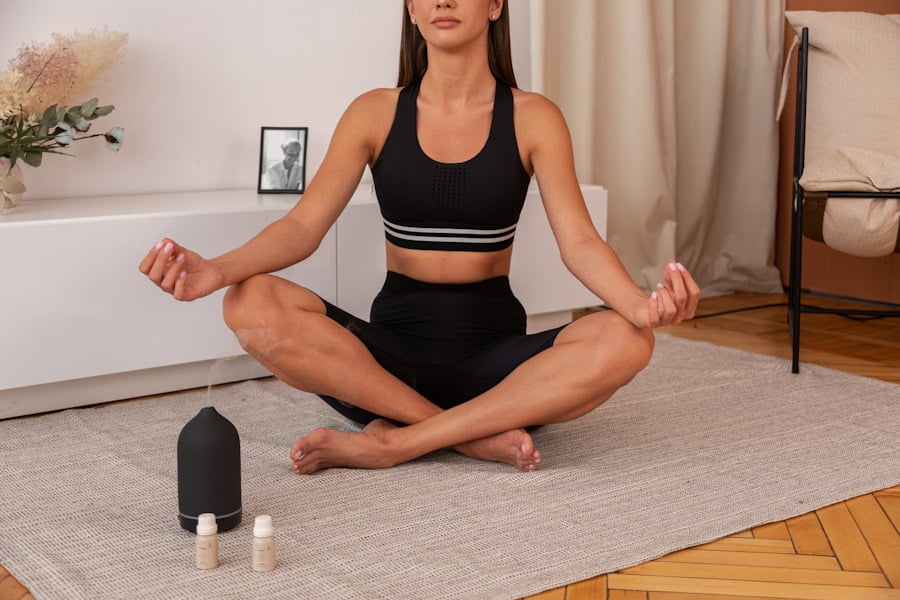
Stress-relieving exercises for relaxation
Stress is a common part of life, and it can have a significant impact on both our physical and mental health. When we experience stress, our bodies release hormones that can lead to increased heart rate, elevated blood pressure, and weakened immune function. In addition, chronic stress can contribute to the development of conditions such as anxiety, depression, and cardiovascular disease.
One effective way to combat the negative effects of stress is through stress-relieving exercises. Engaging in regular physical activity has been shown to reduce stress levels and improve overall well-being. Exercise releases endorphins, which are natural mood boosters, and it also helps to reduce the levels of stress hormones in the body. Incorporating stress-relieving exercises into your daily routine can have a profound impact on your physical and mental health.
Key Takeaways
- Stress-relieving exercises are important for maintaining mental and physical health.
- Mind-body exercises like yoga and tai chi can help reduce stress and promote relaxation.
- Breathing exercises and progressive muscle relaxation techniques can also be effective in managing stress.
- Cardiovascular and strength training exercises can help reduce stress and improve overall health.
- Outdoor activities like hiking and gardening can provide a natural and enjoyable way to relieve stress.
Mind-Body Exercises for Relaxation
Mind-body exercises are a type of physical activity that combines movement with mental focus and relaxation techniques. These exercises are designed to promote a sense of calm and well-being by integrating the mind and body. They can be particularly effective for stress relief because they help to quiet the mind and release tension from the body.
One of the key benefits of mind-body exercises is their ability to reduce the production of stress hormones in the body. When we are stressed, our bodies go into “fight or flight” mode, which triggers the release of cortisol and adrenaline. Mind-body exercises help to counteract this response by activating the body’s relaxation response, which reduces the production of stress hormones.
Examples of mind-body exercises include yoga, tai chi, and Pilates. These exercises focus on controlled movements, deep breathing, and mindfulness techniques to promote relaxation and reduce stress levels.
Yoga Poses for Stress Relief
Yoga is a popular mind-body exercise that has been practiced for thousands of years. It combines physical postures with breathing exercises and meditation to promote relaxation and improve overall well-being. Yoga has been shown to reduce stress levels, improve sleep quality, and increase feelings of calm and contentment.
There are several yoga poses that are particularly effective for stress relief. One example is the Child’s Pose, which involves sitting on your knees and bending forward to rest your forehead on the ground. This pose helps to release tension in the back and shoulders and promotes a sense of relaxation.
Another effective yoga pose for stress relief is the Legs-Up-The-Wall pose. To perform this pose, lie on your back with your legs extended up against a wall. This pose helps to calm the nervous system and promote relaxation.
To perform these poses, start by finding a quiet space where you can practice without distractions. Begin by taking a few deep breaths to center yourself, then move into the pose slowly and mindfully. Hold each pose for several breaths, focusing on relaxing the body and releasing tension.
Tai Chi for Stress Reduction
Tai chi is a traditional Chinese martial art that combines slow, flowing movements with deep breathing and mental focus. It is often referred to as “moving meditation” because it promotes a sense of calm and relaxation while also improving physical strength and balance.
One of the key benefits of tai chi for stress reduction is its ability to activate the body’s relaxation response. The slow, deliberate movements of tai chi help to calm the mind and release tension from the body, reducing stress levels and promoting a sense of well-being.
To perform tai chi, start by finding a quiet space where you can practice without distractions. Begin by standing with your feet shoulder-width apart and your knees slightly bent. Take a few deep breaths to center yourself, then begin to move through a series of slow, flowing movements. Focus on coordinating your breath with your movements, and try to maintain a relaxed and calm state of mind throughout the practice.
Breathing Exercises for Relaxation
Deep breathing exercises are a simple and effective way to reduce stress and promote relaxation. When we are stressed, our breathing tends to become shallow and rapid, which can contribute to feelings of anxiety and tension. Deep breathing exercises help to counteract this response by slowing down the breath and activating the body’s relaxation response.
One of the most basic breathing exercises for stress relief is diaphragmatic breathing. To perform this exercise, start by finding a comfortable seated position. Place one hand on your chest and the other hand on your abdomen. Take a deep breath in through your nose, allowing your abdomen to rise as you fill your lungs with air. Exhale slowly through your mouth, allowing your abdomen to fall as you release the breath. Repeat this exercise several times, focusing on taking slow, deep breaths and allowing your body to relax with each exhale.
There are many different types of breathing exercises that can be used for stress relief, including alternate nostril breathing, box breathing, and 4-7-8 breathing. Experiment with different techniques to find the ones that work best for you.
Progressive Muscle Relaxation Techniques

Progressive muscle relaxation is a technique that involves tensing and then releasing different muscle groups in the body to promote relaxation and reduce stress levels. This technique helps to increase body awareness and release tension from the muscles, leading to a sense of calm and well-being.
To perform progressive muscle relaxation, start by finding a quiet space where you can lie down comfortably. Begin by taking a few deep breaths to center yourself, then focus on one muscle group at a time. Start with your toes and work your way up through your legs, abdomen, chest, arms, and finally your face and head. As you focus on each muscle group, tense the muscles for a few seconds, then release the tension and allow the muscles to relax completely. Move through each muscle group in this way, taking your time and allowing yourself to fully relax.
Cardiovascular Exercises for Stress Relief
Cardiovascular exercises, also known as aerobic exercises, are a type of physical activity that increases the heart rate and improves cardiovascular fitness. These exercises include activities such as running, swimming, cycling, and dancing. Engaging in regular cardiovascular exercise has been shown to reduce stress levels and improve overall well-being.
One of the key benefits of cardiovascular exercise for stress relief is its ability to release endorphins, which are natural mood boosters. When we engage in aerobic exercise, our bodies produce endorphins that help to reduce feelings of stress and promote a sense of well-being.
To perform cardiovascular exercises, start by choosing an activity that you enjoy and that gets your heart rate up. Aim for at least 30 minutes of moderate-intensity exercise most days of the week. If you are new to exercise or have any health concerns, it is important to consult with your healthcare provider before starting a new exercise program.
Strength Training for Stress Management
Strength training exercises involve using resistance, such as weights or resistance bands, to build muscle strength and endurance. These exercises can be particularly effective for stress management because they help to release tension from the muscles and promote a sense of empowerment and confidence.
One of the key benefits of strength training for stress management is its ability to increase the production of endorphins. When we engage in strength training exercises, our bodies release endorphins that help to reduce feelings of stress and improve mood.
There are many different types of strength training exercises that can be performed, including squats, lunges, push-ups, and bicep curls. To perform these exercises, start by choosing a weight or resistance level that challenges you but allows you to maintain proper form. Begin with a warm-up to prepare your muscles for exercise, then move through each exercise slowly and mindfully. Aim for 2-3 sets of 8-12 repetitions for each exercise, resting for 1-2 minutes between sets.
Outdoor Activities for Stress Reduction
Spending time in nature has been shown to have a profound impact on our physical and mental health. Outdoor activities can help to reduce stress levels, improve mood, and increase feelings of well-being. Whether it’s going for a hike, gardening, or simply sitting in a park, spending time outdoors can provide a much-needed break from the stresses of daily life.
One of the key benefits of outdoor activities for stress reduction is their ability to promote relaxation and reduce feelings of anxiety. Being in nature has a calming effect on the mind and body, helping to reduce stress levels and improve overall well-being.
To incorporate outdoor activities into your routine, start by finding activities that you enjoy and that allow you to connect with nature. Whether it’s going for a walk in the park, taking up gardening, or exploring new hiking trails, find ways to spend time outdoors that bring you joy and help you to relax.
Incorporating Stress-Relieving Exercises into Your Daily Routine
Incorporating stress-relieving exercises into your daily routine can have a profound impact on your physical and mental health. Whether it’s practicing yoga, tai chi, or engaging in cardiovascular exercise, finding ways to reduce stress levels is essential for overall well-being.
To make exercise a habit, it’s important to start small and gradually increase the intensity and duration of your workouts. Set realistic goals for yourself and find activities that you enjoy and that fit into your schedule. Remember that any amount of physical activity is better than none, so even if you only have a few minutes each day, find ways to move your body and release tension.
In addition to regular exercise, it’s also important to prioritize self-care and relaxation techniques such as deep breathing, progressive muscle relaxation, and spending time outdoors. By incorporating these stress-relieving exercises into your daily routine, you can reduce stress levels, improve overall well-being, and live a healthier, happier life.
FAQs
What are stress-relieving exercises?
Stress-relieving exercises are physical activities that help reduce stress and promote relaxation. These exercises can include yoga, meditation, deep breathing, progressive muscle relaxation, and other techniques.
How do stress-relieving exercises work?
Stress-relieving exercises work by activating the body’s relaxation response, which helps to counteract the effects of stress. These exercises can help reduce muscle tension, lower blood pressure, slow down breathing and heart rate, and promote feelings of calm and well-being.
What are some examples of stress-relieving exercises?
Some examples of stress-relieving exercises include yoga, tai chi, meditation, deep breathing, progressive muscle relaxation, guided imagery, and visualization.
How often should I do stress-relieving exercises?
The frequency of stress-relieving exercises depends on individual needs and preferences. Some people may benefit from doing these exercises daily, while others may find that doing them a few times a week is sufficient.
Are stress-relieving exercises safe for everyone?
Stress-relieving exercises are generally safe for most people. However, it is important to consult with a healthcare provider before starting any new exercise program, especially if you have any underlying health conditions or injuries.
Can stress-relieving exercises help with anxiety and depression?
Yes, stress-relieving exercises can be helpful for managing symptoms of anxiety and depression. These exercises can help reduce feelings of stress and promote relaxation, which can improve mood and overall well-being. However, it is important to seek professional help if you are experiencing severe or persistent symptoms of anxiety or depression.


















